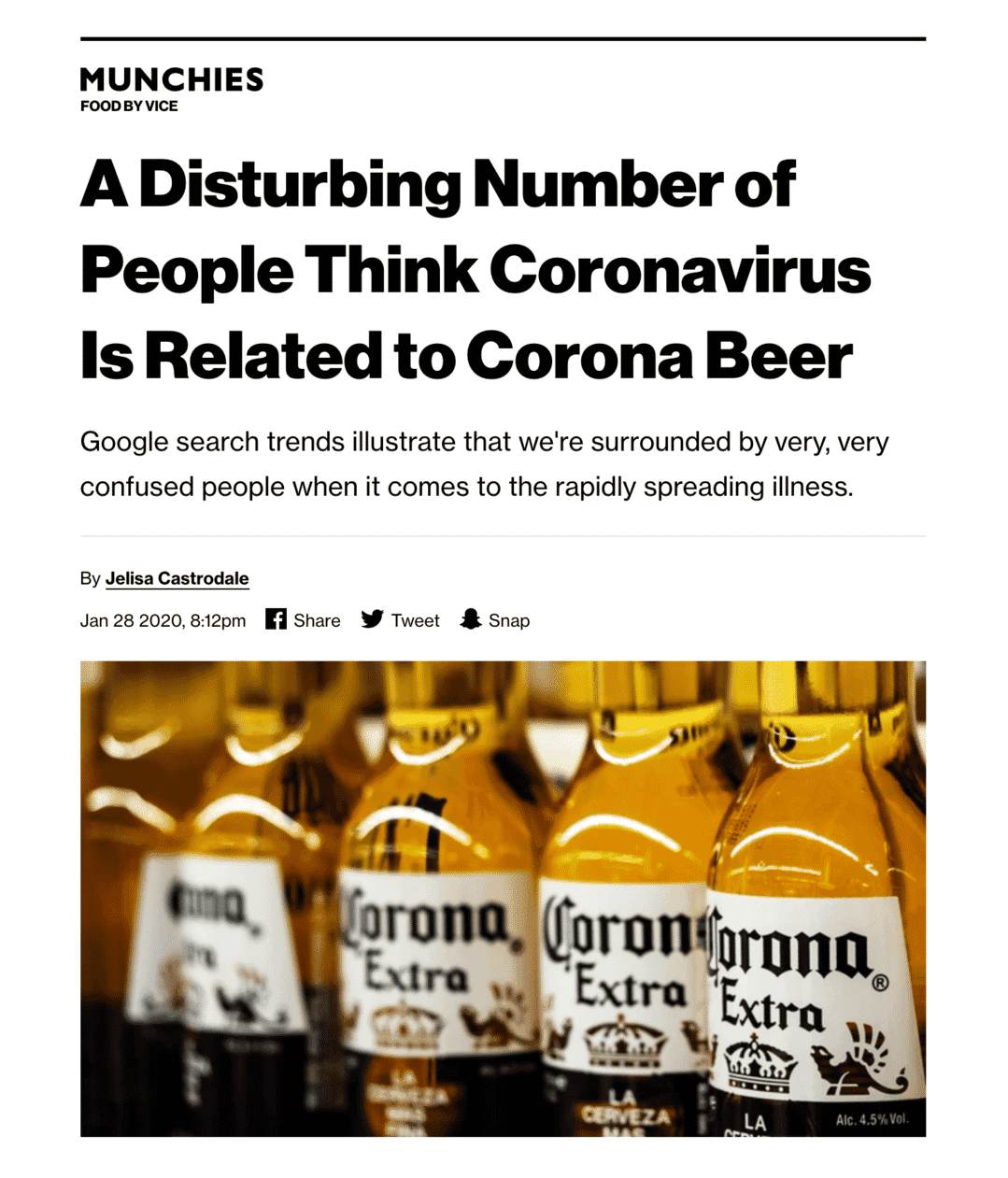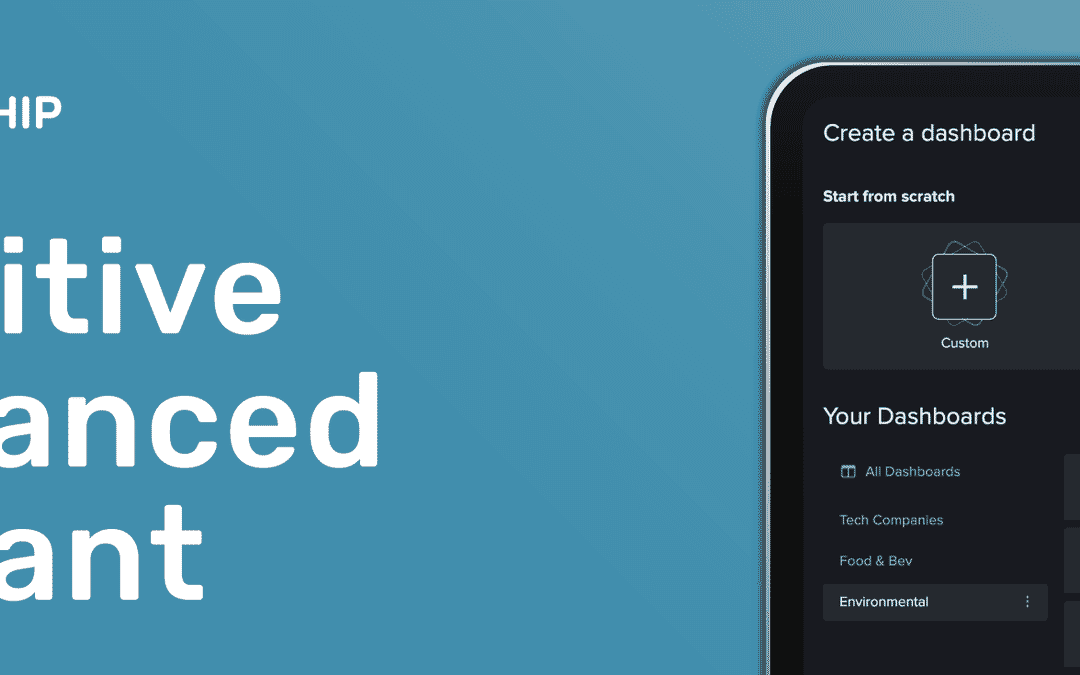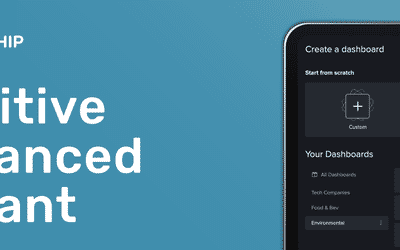How the coronavirus has spread online
The new coronavirus that originated in Wuhan at the end of 2019 has gone from unheard of to being declared a global health emergency in the space of a month. As you might expect, the online attention it received has also exploded in that time, and we wanted to track engagement to coronavirus stories on a week to week basis using NewsWhip data.
Let’s start at the end of December last year. For the sake of consistency, any reference to the times and dates that articles were published are standardized to US Eastern Time.
Week 1: December 2019 / January 2020
January 2nd 2020
First mention of coronavirus in English
Either way, the first site to mention Wuhan in the headline alongside coronavirus was the website FluTrackers, which tracks the spread of diseases online, and claims to have been doing so since 2006. This site claimed there were up to 59 cases of undiagnosed viral pneumonia in Wuhan specifically.
After this, attention started to pick up for some publishers, with Sputnik and Virology Down Under both writing about the undiagnosed victim in Wuhan, though the number dropped to 44 rather than the aforementioned 59. These stories, though, did not generate any significant engagement, with even the stories with the highest interaction rate only seeing those interactions number in the low hundreds.
Week 1: Summary
Over the course of this week, there were fourteen articles combining for around 1,500 engagements, so there was relatively little pickup outside of local sources and blogs.
1,500
Engagements
Week 2: January 6th – 12th 2020
january 8TH 2020
New York Times
This included The New York Times publishing a piece on January 8th, still reporting of a disease with pneumonia-like symptoms. This was one of the most engaged articles of the week, with 2,297 engagements.
2,297
Interactions
January 9TH 2020
WHO
The World Health Organization issued a statement of its own on January 9th, linking the outbreak of pneumonia symptoms to a novel coronavirus. This statement received just over 3,000 engagements.
3,183
Interactions
38,657
Views
38,657
Views
January 11th 2020
NBC
The top article of the week came from NBC on January 11th, with reporting of the first death from this new coronavirus. This story received 8,785 engagements.
8,785
Interactions
Week 2: Summary
Although the coronavirus received significantly more press and social traction this week than the one that came before, it still saw relatively low engagements, especially for a newly discovered, potentially fatal disease. This week saw 90,000 engagements on around 1,300 articles, so while it was significantly more, it was hardly a critical mass.
90,000
Interactions
Week 3: January 13th – 19th 2020
January 20th 2020
BBC News
The biggest story this week came from BBC News, confirming cases had tripled through infection. This received 767,000 engagements, more than half of the 1.2 million engagements that week. The sheer enormousness of this article pushed the subject into the mass consciousness almost by itself, with no other article that week topping 22,000 engagements.
767,000
Engagements
Week 3: Summary
This is the week where engagement began to reach a tipping point, topping a million for the week for the first time since it began to be reported on. The number of articles increased to 3,500, but crucially the average engagements per article increased to 350, having been at 70 the week before, which is what drove engagement over a million.
For clarity, the BBC article was actually published just after midnight GMT on January 20th, but as mentioned, this analysis looks at everything through EST for consistency, meaning it counts towards this week’s engagement numbers, albeit only barely. This set the tone for the coverage of the week of January 20th, either way.
1,232,274
Engagements
Week 4: January 20th – 26th 2020
After the mass success of the BBC article from the week before, the week of January 20th gave way to an explosion of speculation about the origins of the virus and how broad its effects could be.
January 23-27TH 2020
Origins of coronavirus
A lot of the top stories this week were driven by British tabloids, pointing out the variety of animals eaten in China and making links between that and the virus, or writing about the “zombie wasteland” of the outbreak site of Wuhan.
The Daily Mail and The Sun were two of the chief explorers of this narrative.
Week 4: Summary
This was the week that the coronavirus truly hit the heights on panic levels. The number of articles written shot up to almost 65,000 for the week, while average engagements also rose to 571 per article, combining for some 36 million engagements.
36,701,100
Engagements
Week 5: January 27th – February 6th 2020
January 27th 2020
Humor, cures and spread of coronavirus
There was a bit more humor and lightheartedness around the news this week though, with the top article mocking people who assumed the virus was linked to the beer brand Corona, and the second most engaged coming from satire site The Beaverton.
There was also good news this week, with English-language Chinese outlets such as Xinhuanet and China Daily publishing stories about people cured from the disease.
1,504,257
Interactions
1,504,257
Interactions
Week 5: Summary
This was the biggest week in terms of both articles written and total engagements, with 130,000 and 58 million respectively, though average engagements per article did drop back down to 433.
58,519,451
Engagements
Week 6: FEBRUARY 3RD – FEBRUARY 9TH 2020
Last week, it returned back to normal. The reporting became less reactionary and a little more sober, looking at the victims and the spread of the disease in a scientific manner, as well as talking about countries giving aid to China in an attempt to combat it.
February 8th 2020
CNN
The most engaged article this week was about the death of Dr. Li Wenliang, who first sounded the alarm about the impending threat of the coronavirus. He died of the disease on the morning of February 7th.
1,199,527
Engagements
Week 6: Summary
There have been around 120,000 articles written during the course of this week, which between them garnered around 32 million engagements, significantly less than the previous week. The most engaged of these were all about the same thing; the death of Dr. Li Wenliang, who first sounded the alarm about the impending threat of the coronavirus. He died of the disease on the morning of February 7th. CNN’s article about this news garnered more than a million engagements.
32,750,402
Engagements
Summary
Such an incident is a perfect example of how news, and particularly news that is poorly understood, can spiral and snowball online.

Benedict Nicholson
Benedict Nicholson is the Head of Research and Editorial at NewsWhip. An Englishman in New York, he is interested in the intersection of PR, brands, and journalism, and the trends and innovation around that.
Email Benedict via benedict.nicholson@newswhip.com.

Roisin O'Flaherty
Roisin O’Flaherty is the visual designer at NewsWhip. After graduating with her MSc in Cybersychology, she has focused on communicating complex data in visually engaging and interesting ways. She’s most interested in the future of technology and its impact on humanity.
Email Roisin via roisin.oflaherty@newswhip.com.





















